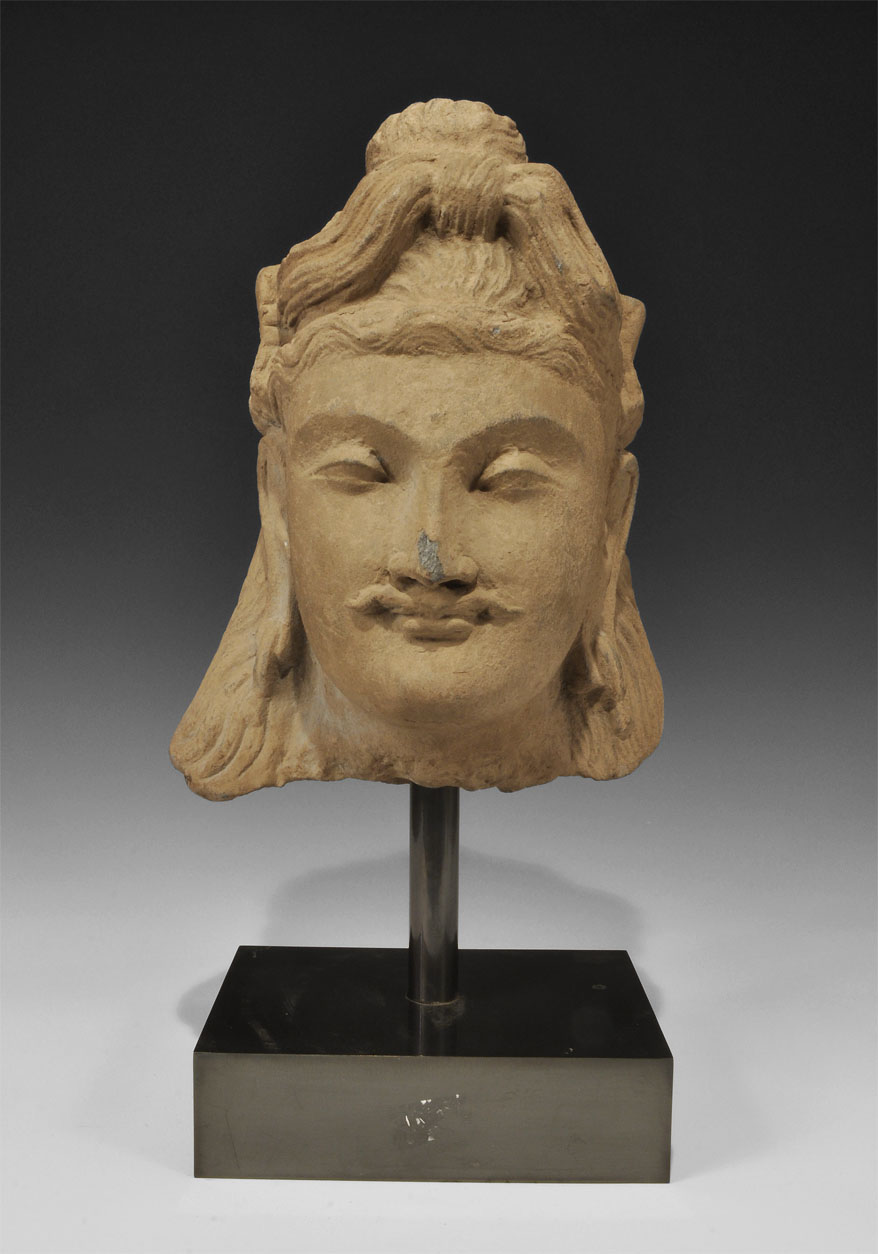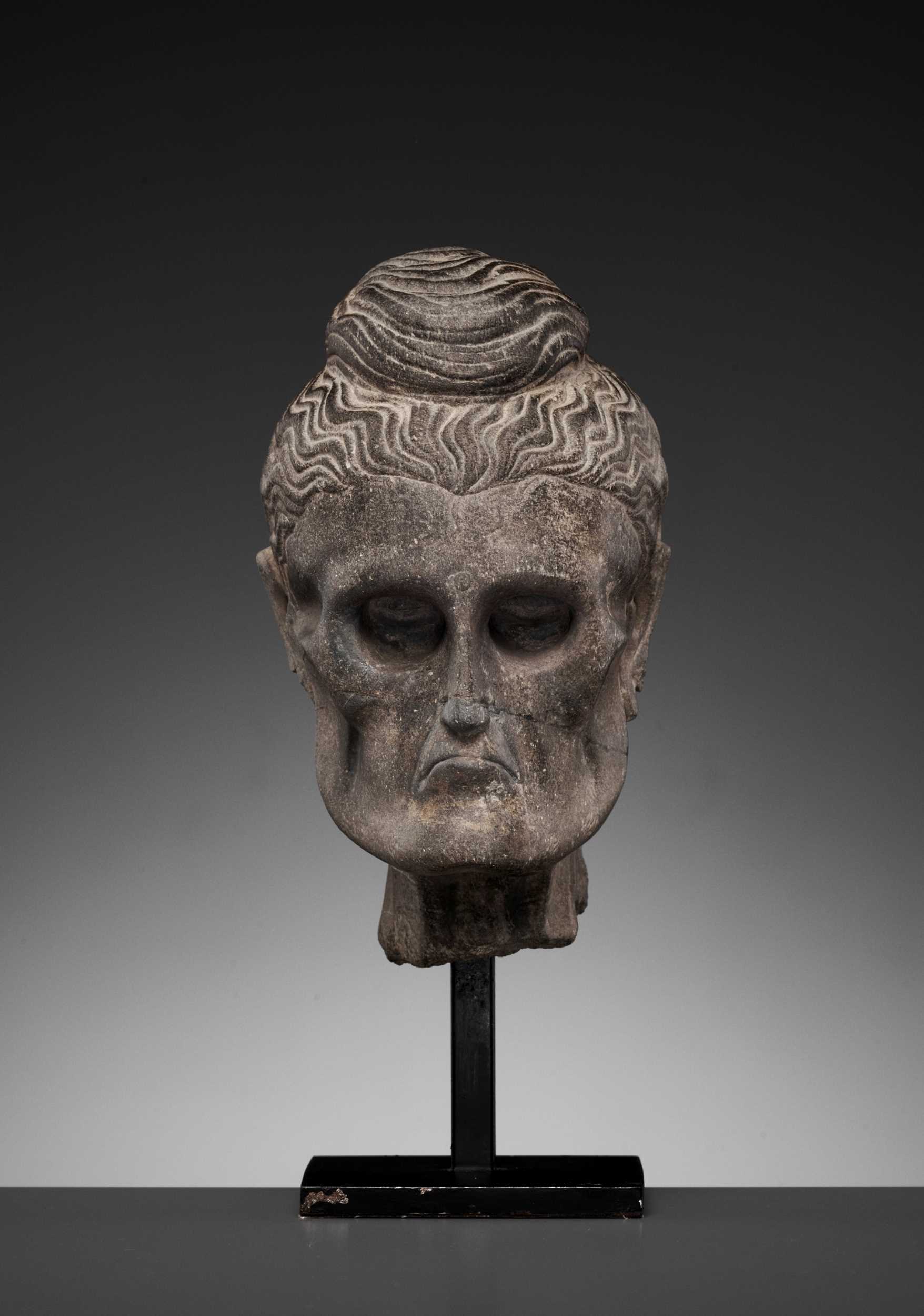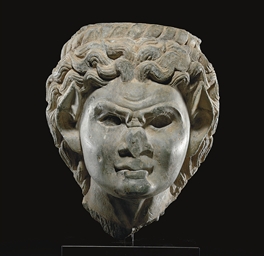Ancient region of Kushan, 3rd century. Depicted at the brink of starvation, sustained asceticism has withered Buddha’s body down to its bare anatomy under paper-thin skin. It clings to the cartilage of his trachea, the brittle muscles of his neck, the veins crisscrossing his forehead. Meanwhile, he glares out beyond the cavernous eye-sockets transfixed with a persistent and emboldened insight. The present sculpture bears the telltale signs of raised edges rubbed smooth where beholders were gripped with the overt temptation to caress the cheekbones or forehead. Provenance: Arthur Huc (1854-1932). Marcel Huc, inherited from the above. Thence by descent within the same family. Arthur Huc was the chief editor of La Dépêche du Midi, at the time the leading newspaper in Toulouse, France. He was also an accomplished art critic and early patron of several artists, including Henri de Toulouse- Lautrec. At the same time, Arthur Huc was a keen collector of Asian art, a passion that he inherited from his legendary ancestor Évariste Régis Huc, also known as the Abbé Huc (1813-1860), a French Catholic priest and traveler who became famous for his accounts of Qing-era China, Mongolia and especially the then-almost-unknown Tibet in his book “Remembrances of a Journey in Tartary, Tibet, and China”. Condition: Excellent condition, commensurate with age. Extensive wear, weathering, structural cracks and signs of deep erosion. Naturally grown, even, dark patina. Two areas of loss (one to hair and one to proper left eyebrow), both with minor remnants of old fill. Soil encrustations, mostly to back. Remnants of old varnish. Inventory List: In 1954, L. Magniette, bailiff of the court in Toulouse (Huissier), was ordered to compile a complete inventory of the collection inherited by Marcel Huc from his father, Arthur Huc, the so-called “Inventaire Huc”. The present lot is listed in this inventory as follows: “Tête de Bouddha émacié. Haut 54 cm. Schiste.” (Head of an emaciated Buddha. Height 54 cm. Schist.) A copy of the inventory list and cover page are accompanying this lot. French Export License: Certificat d’exportation pour un bien culturel Nr. 185431 dated 3 July 2017 has been granted and is accompanying this lot. Weight: 38.7 kg Dimensions: Height 54 cm (excl. stand) and 68 cm (incl. stand) With an associated modern stand. (2) Compared to the abundance of Siddharthas, Teaching Buddhas, and Maitreyas, only three Gandharan sculptures of Emaciated Buddha are known from excavation records, making them not only one of the most evocative, but also rarest images from the ancient region of Gandhara, and the Buddhist world at-large. Famous examples are held in the Lahore Museum, the Peshawar Museum, and The Metropolitan Museum of Art (see Khan, Gandhara: The Buddhist Civilization from Pakistan, Beijing, 2009, pages 224-225, and Ingholt, Gandharan Art in Pakistan, New York, 1957, no. 53, and Behrendt, The Art of Gandhara, New Haven, 2007, pages 56-57, nos. 45 & 46, respectively). Scholars believe the subject refers to one of two pivotal moments in Buddha's life. Some, that it depicts the six years Siddhartha spent accomplishing the extreme asceticism promulgated by Brahmanic sages of his time, before renouncing its folly and proclaiming Buddhism's middle path to enlightenment between the extremes of austerities and sensual indulgence. Others, that it portrays Buddha rapt within seven weeks of sustained meditation immediately following his enlightenment, fasting all the while (Behrendt, The Art of Gandhara, New Haven, 2007, pages 57-58). As Behrendt points out, these rare depictions of Buddha were 'first among the ascetics [and would have appealed] to a lay community that respected religious figures who had full control of ascetic disciplines, [as] part of an effort to bring these groups into the Buddhist fold' (ibidem). Literature comparison: Compare a related schist head of the Fasting Siddharta, dated ca. 3rd-5th century, in the collection of the Metrop
Ancient region of Kushan, 3rd century. Depicted at the brink of starvation, sustained asceticism has withered Buddha’s body down to its bare anatomy under paper-thin skin. It clings to the cartilage of his trachea, the brittle muscles of his neck, the veins crisscrossing his forehead. Meanwhile, he glares out beyond the cavernous eye-sockets transfixed with a persistent and emboldened insight. The present sculpture bears the telltale signs of raised edges rubbed smooth where beholders were gripped with the overt temptation to caress the cheekbones or forehead. Provenance: Arthur Huc (1854-1932). Marcel Huc, inherited from the above. Thence by descent within the same family. Arthur Huc was the chief editor of La Dépêche du Midi, at the time the leading newspaper in Toulouse, France. He was also an accomplished art critic and early patron of several artists, including Henri de Toulouse- Lautrec. At the same time, Arthur Huc was a keen collector of Asian art, a passion that he inherited from his legendary ancestor Évariste Régis Huc, also known as the Abbé Huc (1813-1860), a French Catholic priest and traveler who became famous for his accounts of Qing-era China, Mongolia and especially the then-almost-unknown Tibet in his book “Remembrances of a Journey in Tartary, Tibet, and China”. Condition: Excellent condition, commensurate with age. Extensive wear, weathering, structural cracks and signs of deep erosion. Naturally grown, even, dark patina. Two areas of loss (one to hair and one to proper left eyebrow), both with minor remnants of old fill. Soil encrustations, mostly to back. Remnants of old varnish. Inventory List: In 1954, L. Magniette, bailiff of the court in Toulouse (Huissier), was ordered to compile a complete inventory of the collection inherited by Marcel Huc from his father, Arthur Huc, the so-called “Inventaire Huc”. The present lot is listed in this inventory as follows: “Tête de Bouddha émacié. Haut 54 cm. Schiste.” (Head of an emaciated Buddha. Height 54 cm. Schist.) A copy of the inventory list and cover page are accompanying this lot. French Export License: Certificat d’exportation pour un bien culturel Nr. 185431 dated 3 July 2017 has been granted and is accompanying this lot. Weight: 38.7 kg Dimensions: Height 54 cm (excl. stand) and 68 cm (incl. stand) With an associated modern stand. (2) Compared to the abundance of Siddharthas, Teaching Buddhas, and Maitreyas, only three Gandharan sculptures of Emaciated Buddha are known from excavation records, making them not only one of the most evocative, but also rarest images from the ancient region of Gandhara, and the Buddhist world at-large. Famous examples are held in the Lahore Museum, the Peshawar Museum, and The Metropolitan Museum of Art (see Khan, Gandhara: The Buddhist Civilization from Pakistan, Beijing, 2009, pages 224-225, and Ingholt, Gandharan Art in Pakistan, New York, 1957, no. 53, and Behrendt, The Art of Gandhara, New Haven, 2007, pages 56-57, nos. 45 & 46, respectively). Scholars believe the subject refers to one of two pivotal moments in Buddha's life. Some, that it depicts the six years Siddhartha spent accomplishing the extreme asceticism promulgated by Brahmanic sages of his time, before renouncing its folly and proclaiming Buddhism's middle path to enlightenment between the extremes of austerities and sensual indulgence. Others, that it portrays Buddha rapt within seven weeks of sustained meditation immediately following his enlightenment, fasting all the while (Behrendt, The Art of Gandhara, New Haven, 2007, pages 57-58). As Behrendt points out, these rare depictions of Buddha were 'first among the ascetics [and would have appealed] to a lay community that respected religious figures who had full control of ascetic disciplines, [as] part of an effort to bring these groups into the Buddhist fold' (ibidem). Literature comparison: Compare a related schist head of the Fasting Siddharta, dated ca. 3rd-5th century, in the collection of the Metrop







.jpg)







Try LotSearch and its premium features for 7 days - without any costs!
Be notified automatically about new items in upcoming auctions.
Create an alert